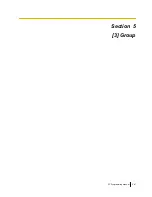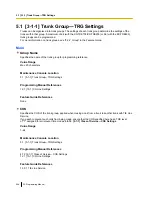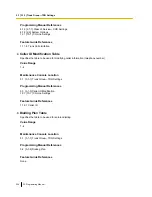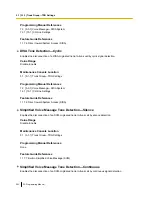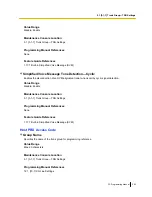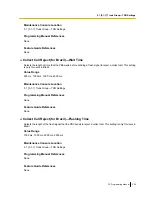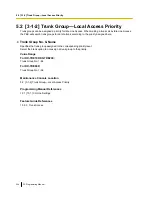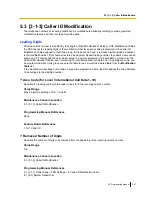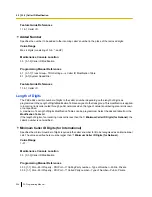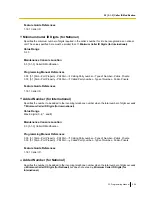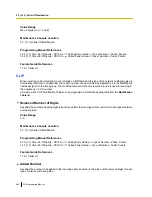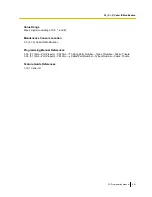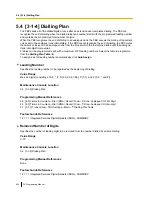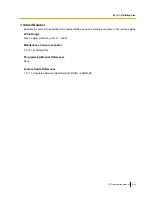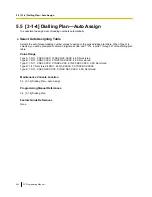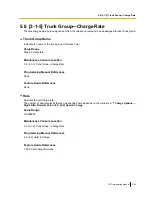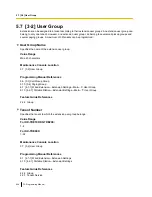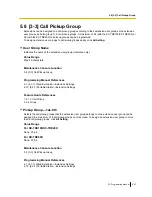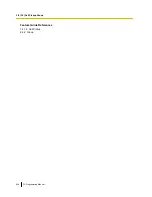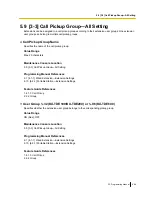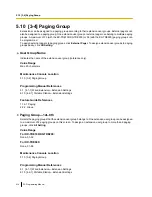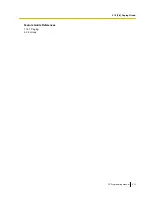
5.3 [3-1-3] Caller ID Modification
The telephone numbers of incoming callers can be modified automatically according to preprogrammed
modification tables, and then recorded for calling back.
Leading Digits
After the caller’s number is modified by the Length of Digits Modification Tables or CLIP Modification Tables,
the PBX checks the leading digits of the modified number for an area code programmed in the Caller ID
Modification Table assigned to that trunk group. If it finds such a code, it removes digits and adds a number
to the modified number. If this number is stored as a System Speed Dialling number, the caller’s name can be
shown on a PT display and the call can be routed to a certain extension (CLI destination). A maximum of 4
Caller ID Modification Tables, each containing 10 local/international call data and 1 long distance code, can
be programmed. Each trunk group can select a table for use. Select the desired table from the
Modification
Table
list.
If the modified number does not contain an area code programmed here, the PBX applies the Long Distance
Code settings to the modified number.
Area Code (for Local / International Call Data 1–10)
Specifies the leading number (area code) to look for in the incoming caller’s number.
Value Range
Max. 6 digits (consisting of 0–9, *, and #)
Maintenance Console Location
5.3 [3-1-3] Caller ID Modification
Programming Manual References
None
Feature Guide References
1.18.1 Caller ID
Removed Number of Digits
Specifies the number of digits to be removed from the beginning of the incoming caller’s number.
Value Range
0–9
Maintenance Console Location
5.3 [3-1-3] Caller ID Modification
Programming Manual References
5.1 [3-1-1] Trunk Group—TRG Settings—
Caller ID Modification Table
8.1 [6-1] System Speed Dial
PC Programming Manual
597
5.3 [3-1-3] Caller ID Modification
Summary of Contents for KX-TDE100
Page 10: ...Feature Programming References 977 10 PC Programming Manual Table of Contents ...
Page 14: ...Table 2 For CE model 14 PC Programming Manual 1 1 2 Entering Characters ...
Page 15: ...Table 3 For RU model PC Programming Manual 15 1 1 2 Entering Characters ...
Page 16: ...Table 4 For GR model 16 PC Programming Manual 1 1 2 Entering Characters ...
Page 103: ...Section 3 1 Configuration PC Programming Manual 103 ...
Page 457: ...Section 4 2 System PC Programming Manual 457 ...
Page 586: ...586 PC Programming Manual 4 21 2 11 2 Audio Gain Card ...
Page 587: ...Section 5 3 Group PC Programming Manual 587 ...
Page 663: ...Section 6 4 Extension PC Programming Manual 663 ...
Page 818: ...Feature Guide References None 818 PC Programming Manual 6 17 4 3 DSS Console ...
Page 820: ...820 PC Programming Manual 6 18 4 3 DSS Console DSS key data copy ...
Page 821: ...Section 7 5 Optional Device PC Programming Manual 821 ...
Page 848: ...848 PC Programming Manual 7 7 5 5 External Sensor ...
Page 849: ...Section 8 6 Feature PC Programming Manual 849 ...
Page 869: ...Section 9 7 TRS PC Programming Manual 869 ...
Page 877: ...Section 10 8 ARS PC Programming Manual 877 ...
Page 889: ...Section 11 9 Private Network PC Programming Manual 889 ...
Page 901: ...Section 12 10 CO Incoming Call PC Programming Manual 901 ...
Page 930: ...930 PC Programming Manual 12 7 10 5 Miscellaneous ...
Page 931: ...Section 13 11 Maintenance PC Programming Manual 931 ...
Page 968: ...968 PC Programming Manual 13 6 11 5 Air Synchronisation ...
Page 969: ...Section 14 Appendix PC Programming Manual 969 ...
Page 976: ...976 PC Programming Manual 14 1 4 KX TDE600 PGMPR Software File Version 3 0xxx ...
Page 977: ...Feature Programming References PC Programming Manual 977 ...
Page 1017: ...PC Programming Manual 1017 Notes ...





